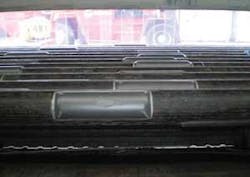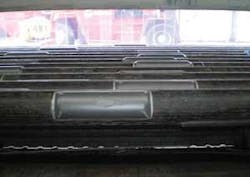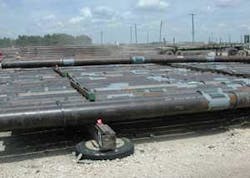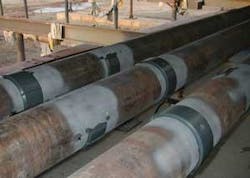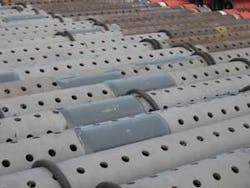A composite carbon-fiber material bonded directly on the pipe surface provides an alternative for obtaining standoff for completion and drilling tools, production riser systems, pipe-in-pipe flowlines, and road and river crossings.
Halliburton in 2008 acquired Protech Centerform, Protech has a license to manufacture the material from ENI SPA,the developer and holder of the patent for the material.
Halliburton notes that the first commercial application of the centralizers was on 16-in. and 133/8-in. casing for Eni SPA in the Cascina Cardana 1 gas well in the Po Valley of Italy in 2000, and the most common application of the material is for centralizing casing and liners in highly deviated or sidetrack wells.
Carbon-fiber centralizers
Protech’s website says molded-on centralizer blades or buttons greatly expand versatility while reducing overall project cost from design through completion. For example, the design engineer can now use slim-hole centralization without stop collar rings around the outside of the casing wall, providing a smooth and uninterrupted flow during circulation.
Because the elasticity of the composite is higher than for steel casing, the material reduces if not completely eliminates problems with casing centralizer stiffness, the company says.
It adds that an economic advantage is that the material allows adequate casing or liner standoff for acceptable cement placement even in deviated wells with slim hole or lean profiles such as 16-in. casing in a 17-in. hole or 133/8-in. casing in a 14-in. borehole.
The company says that it has standardized the material for the centralizers but also can customize it. It can bond the material to pipe in various geometries or shapes such as spiral blades, staggered blades, or buttons; and it commonly applies it to tubulars at the pipe yard, although it can also do this at the rig site.
The most common applications are solid standoffs, although using the material in conjunction with close tolerance bow springs provides a technically and commercially sound alternative in underreamed holes, the company notes. It adds that in the US, 90% of the applications have been on casing and liners run in Gulf of Mexico deepwater wells.
The standardized material has a 350° F. temperature limitation.
Figs. 1-4 show the centralizers on various tubulars.
Centralizer compositions
The material for the composite centralizers consists of a combination of a bicomponent amine-cured epoxy resin compounded with a polyurethane hybrid (for flexibility), AL203 (Alumina), SiC (silicon carbide), TiN (titanium nitride) particulate, and chopped carbon fiber, along with chemically binding the fillers to the resin.
Properties of the material include:
- Direct tensile strength: 5,510 psi.
- Compressive strength: 21,021 psi.
- Flexural strength: 16,820 psi.
- Impact strength: 11 kJ/sq m.
- Specific gravity (mixed material): 1.675.
- Glass transition temperature: 152° C., following postcure.
- Dialectic strength: >29 kv @ 1 mm.
- Abrasion resistance: 6 mg.
- Hardness: 88.
- Shear bond: 4,022 psi.
